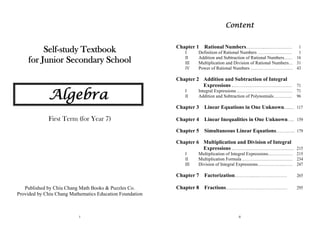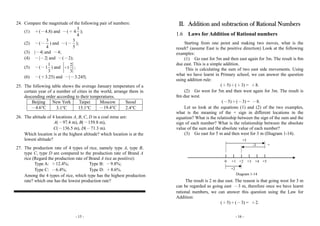This document is an introduction to an algebra textbook for junior secondary school students in China. It covers rational numbers including positive and negative integers and fractions. It defines rational numbers on a number line with positive numbers to the right of zero and negative numbers to the left. It explains how to represent rational numbers as points on a number axis and gives examples of locating positive and negative integers and fractions on the axis. The textbook contains 8 chapters on topics like rational numbers, equations, inequalities and expressions and provides guidance for self-study.











![- 19 -
Try with two other numbers.
Regarding the addition of rational numbers, there is the
following Commutative Law for Addition:
When adding two numbers together, the sum is the same
regardless of the order of addition. That is
Commutative Law for Addition: a + b = b + a.
Here a, b are any two rational numbers.
Compute: [(+8)+(-5)]+(-4); (+8)+[(-5)+(-4)].
Do you arrive the same result for these two computation?
Try with a different sets of three numbers.
Regarding the addition of rational numbers, there is the
following Associative Law for Addition:
When adding three numbers together, the sum is the same if
we add the first two numbers first, or add the last two numbers
first.
Associative Law for Addition: (a + b) + c= a + (b + c).
Here a, b, c are any three rational numbers.
From the Commutative law of Addition and Associative law for
Addition, we can derive the following rule: when adding three of or
more rational numbers together, we can add the numbers in any order
and under any grouping.
【Example 1】Compute (+16)+(-25)+(+24)+(-32).
Solution (+16)+(-25)+(+24)+(-32)
= [(+16)+(+24)]+[(-25)+(-32)]
= (+40)+(-57)
= -17
NOTE: In the above example, we group and add numbers with
positive sign and negative sign separately, before adding
the subtotals together. This facilitates computation.
- 20 -
【Example 2】There are 10 packets of rice, each is marked with
reference to a standad weight of 180 kg. If the weight is over 180 kg,
the excess will be recorded as a positive number. If the weight is less
than 180 kg, the underweight will be recorded as a negative number,
the weighting record is as in Diagram1-16. How many kg are the 10
packets of rice being in total over-weight or under-weight? What is
the total weight of the 10 packets of rice?
Solution (+7)+(+5)+(-4)+(+6)+(+4)
+(+3)+(-3)+(-2)+(+8)+(+1)
= [(+4)+(-4)]+[(+5)+(-3)+(-2)]
+[(+7)+(+6)+(+3)+(+8)+(+1)]
= 0+0+(+25)
=+25
180 × 10 + 25 = 1825.
Answer: They are in total over-weight by 25 kg; The total weight is
1825 kg.
NOTE: In this example, we group the numbers which will add up
to zero together, computation is thereby facilitated.
Exercise 2
1. Compute:
(1) (+3)+(-8); (2) (-3)+(-8);
(3) (+3)+(+8); (4) (-3)+(+8);
(5) (-10)+(+6); (6) (+12)+(-14);
(7) (-5)+(-7); (8) (+6)+(+9);
(9) (-12)+(+18); (10) (-16)+(-9).
+7 +5 -4 +6 +4
+3 -3 -2 +8 +1
Diagram 1-16](https://image.slidesharecdn.com/algebrach1-150809125832-lva1-app6892/85/Algebra-12-320.jpg)







![- 35 -
Practice
Compute:
(1) (-5) × (+8) × (-7) × (-0.25);
(2) (-6)-(-3) ×
1
3
;
(3) (-1) × (+8)+3 × (-2);
(4) 1+0 × (-1)-(-1) × (-1)-(-1) × 0 × (-1);
(5) 3 × 5 × 7-(-3) × (-5) × (-7)-(-3) × (-5) × 7+
3 × (-5) × 7.
1.11 Operation Laws for Multiplication
What are the laws of multiplication we have learnt in primary
school?
While the laws of addition that we have learnt in primary school
are applicable to rational numbers, would the laws of multiplication
be applicable to rational numbers? Let’s read the following examples
(+5) × (-6) = -30; (-6) × (+5) = -30.
therefore (+5) × (-6) = (-6) × (+5).
[(+3) × (-4)] × (-5) = (-12) × (-5) = 60;
(+3) × [(-4) × (-5)] = (+3) × (+20) = 60.
therefore [(+3) × (-4)] × (-5) = (+3) × [(-4) × (-5)].
Try with a different set of numbers。In general, we have:
In multiplication, even we exchange the positions of the two
numbers, the product is still the same.
Commutative Law for Multiplication: ab = ba.
In multiplying 3 numbers together, it does not matter
whether we multiply the first 2 numbers first or multiply the last
2 numbers first, the product is the same.
The Associative Law for Multiplication: (ab)c =
(b )
- 36 -
In this above we write a × b as ab. In situation where it does not
cause any confusion, we usually simplify the expression by replacing
the “×” sign by “‧”, or even omitting it.
Read another example:
5 [(‧ +3)+(-7)] = 5 (‧ -4) = -20,
5 (‧ +3)+5 (‧ -7) = 15+(-35) = -20,
therefore 5 × [(+3)+(-7)] = 5 × (+3)+5 × (-7).
Trying with a different set of numbers, you will arrive at the
same conclusion. In general, we have:
Multiply a sum of 2 numbers by a third number, is the same
as multiplying each of the two numbers by the third number, and
then adding up the two products.
Distributive Law for Multiplication: a(b+c) = ab+ac.
Practice
Write down the law of operation of the following equation? How can
the law be expressed using letters?
1. (Mental) (-4)‧8 = 8‧(-4).
2. (Mental) (3+9)+(-5) = 3+[9+(-5)].
3. (Mental) (-6) [7‧ +2] = (-6) 7‧ +(-6) 2‧ .
4. (Mental) (5 × 4) × 6 = 5 × (4 × 6).
5. (Mental) (-8)+(-9) = (-9)+(-8).
【Example 1】Compute: (
1
4
+
1
6
-
1
2
) × 12.
Solution (
1
4
+
1
6
-
1
2
) × 12 =
1
12
4
× +
1
12
6
× -
1
12
2
×
= 3+2-6
=-1.](https://image.slidesharecdn.com/algebrach1-150809125832-lva1-app6892/85/Algebra-20-320.jpg)















![- 67 -
24. In a coal mine, the altitude of a point A inside
the well is -174.8 m. Going from A to B,
the horizontal distance is 120 m. For every
horizontal distance of 10 m, the altitude is
raised by 0.4 m. Find the altitude of B.
25. Compute:
(1) 5 ÷ 0.1; (2) 5 ÷ 0.01;
(3) 5 ÷ 0.001; (4) 5 ÷ (-0.1);
(5) 5 ÷ (-0.01); (6) 5 ÷ (-0.001);
(7) 0.2 ÷ 0.1; (8) 0.02 ÷ 0.01;
(9) 0.002 ÷ 0.001; (10) (-0.3) ÷ 0.1;
(11) (-0.03) ÷ 0.01; (12) (-0.003) ÷ 0.001.
26. For each of the following equations, find an appropriate number
to fill in the bracket:
(1) (+5) + ( ) = +3, (2) (+3) × ( ) = -6,
(+5) + ( ) = -3, (-3) × ( ) = -6,
(-5) + ( ) = +3, (+6) × ( ) = +3,
(-5) + ( ) = -3; (+6) × ( ) = -3;
(3) (-3) + ( ) = 0,
(-5) × ( ) = 0.
27. For each of the following equations, is it possible to find an
appropriate number to fill in the bracket?
(1) 0 × ( ) = 5;
(2) 0 × ( ) = 0.
28. How many rational numbers when squared equal to 4? Is there a
rational number when squared equal to -4? How many rational
numbers when cubed equal to 8? Is there a rational number when
cubed equal to -8?
(No. 24)
A
B
120 m
- 68 -
29. Compute:
(1)
3 7 7 1
1 1
4 8 12 7
⎛ ⎞ ⎛ ⎞
×− − −⎜ ⎟ ⎜ ⎟
⎝ ⎠ ⎝ ⎠
;
(2) ( )
1 4
2 ( 16)81
4 9
÷ + ÷ −− ;
(3)
2 82 3
0.252 1
5 215 4
⎛ ⎞ ⎛ ⎞÷ − × −− ⎜ ⎟⎜ ⎟
⎝ ⎠⎝ ⎠
;
(4) 2
3( 2.5)( 4) 5( 6)( 3)− − + − − ;
(5) ( )[ ]{ }0.85 512 4 3 10− ÷+ × − ;
(6) 2 3 2
2 ( 2) 5 ( 0.28) ( 2)+ − × − − ÷ − ;
(7) [ ]3 3
( 3) ( 5)( 3) ( 5) ÷ − − −⎡ ⎤− − −⎣ ⎦ .
30. Follow the instruction in the flow chart below, perform the
computation and write the result in the table (For example in the
first cycle, computing (+3) × (+3)-(-5) we get 14,which is
less than 200;in the second cycle,compute 14 × (+3)-(-5),
etc.):
Input
+3
× (+3)
-(-5)
> 200
STOP
Output
No. of
Counting
Result
1 14
2
3
4YES
NO](https://image.slidesharecdn.com/algebrach1-150809125832-lva1-app6892/85/Algebra-36-320.jpg)
